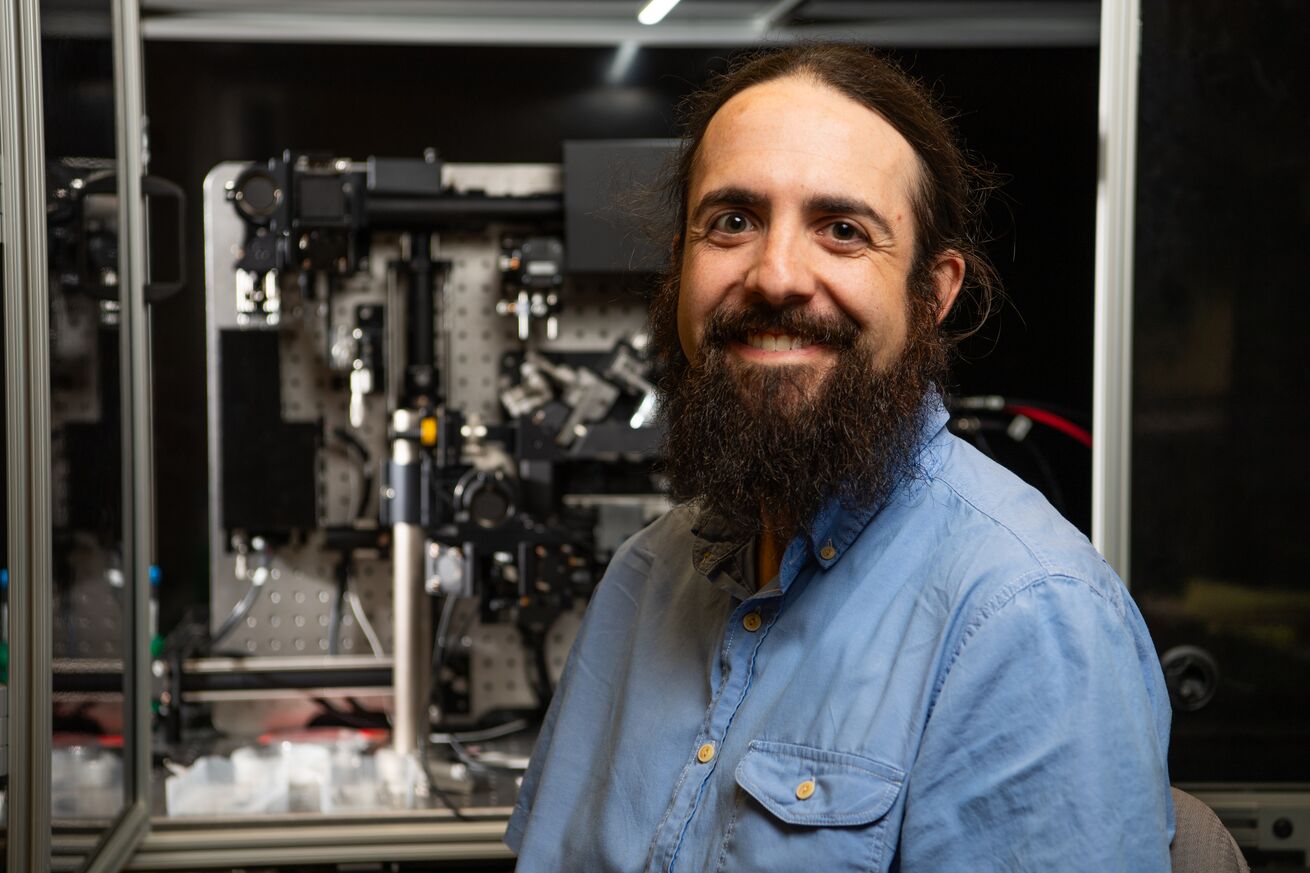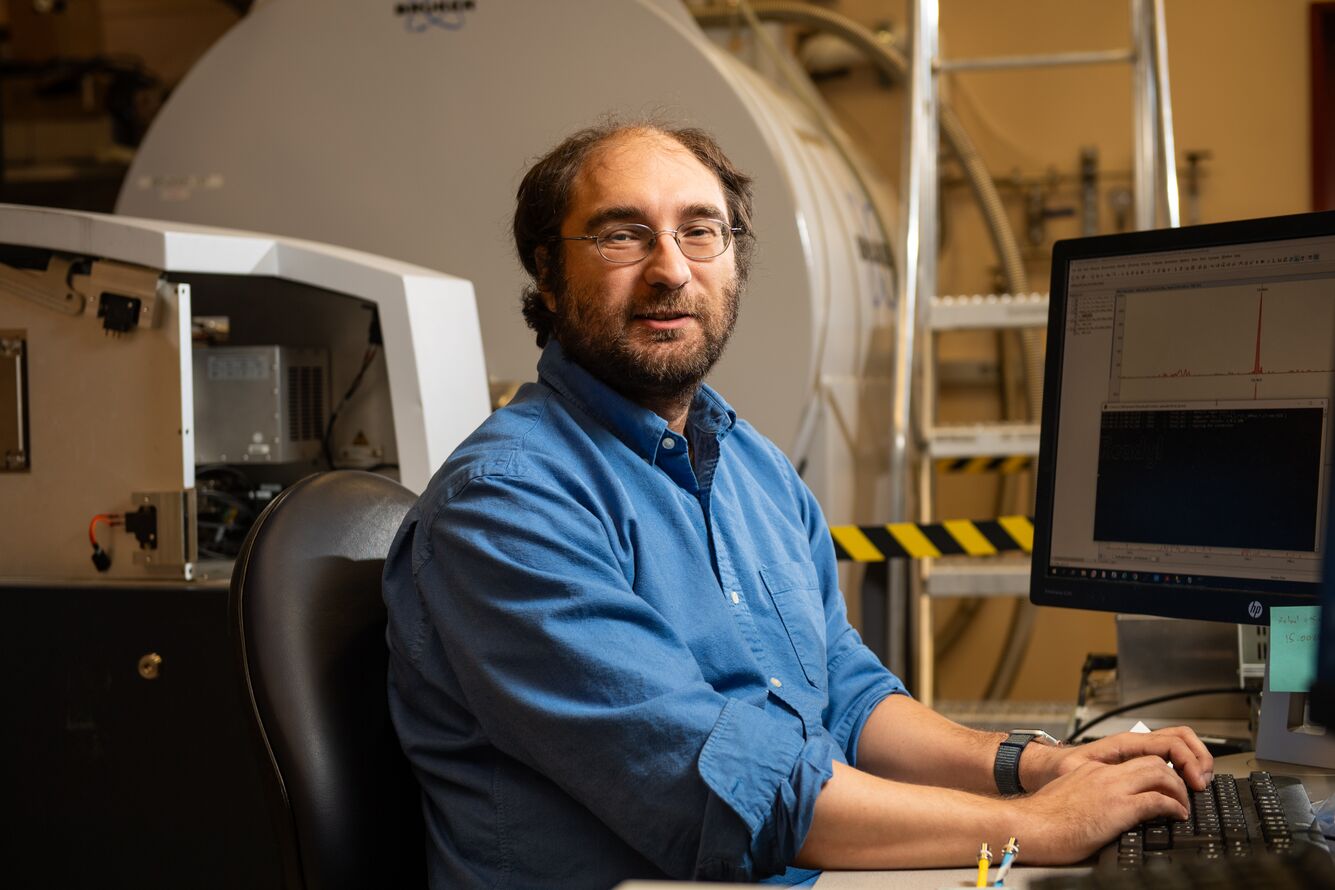Postdocs Take on Scientific Challenges at User Facility
EMSL highlights three researchers who work in environmental, biological, and computational science

Postdocs Jordan Rabus, Brittney Gorman, and Jeremiah Traeger work in EMSL's three science areas—biological, environmental, and computational science. (Photo by Andrea Starr | Pacific Northwest National Laboratory)
Meet Jeremiah Traeger, Brittney Gorman, and Jordan Rabus.
Traeger is a hiker who is also on a quest to bake the perfect loaf of sourdough bread.
Gorman is an ultimate frisbee player who also likes to garden.
And Rabus enjoys working on his vintage Honda motorcycle and hanging with his cats.
Outside their weekends, they are three of the 13 postdoctoral researchers at EMSL, the Environmental Molecular Sciences Laboratory user facility on the Pacific Northwest National Laboratory campus.
They work alongside staff scientists and researchers from around the world to understand some of the most perplexing questions facing biological, environmental, and computational science.
As part of National Postdoc Appreciation Week, EMSL is highlighting Traeger, Gorman, and Rabus and their pathway to science.
Functional and Systems Biology
Jeremiah Traeger
Jeremiah Traeger grew up in a small mountain town in Arizona. He went to college at the University of Arizona where he studied chemical engineering. He earned his doctorate in chemical and biological engineering at the University of Colorado, Boulder.

What is your research area?
I work in super-resolution fluorescence microscopy. Currently, I am working on proteins that we label with light-emitting fluorescent molecules, where we take thousands of images per sample to get very precise measurements on the locations of various immune response proteins in order to further understand the immune pathway of plants.
Why did you become a scientist?
I’ve always been curious about how the universe works, and from a young age would always devour science books trying to understand something. Naturally, I would end up working in a way that encourages me to keep reading on the latest science discoveries.
What is your favorite part about life as a postdoc at EMSL?
I have a lot of appreciation for being able to learn so many new techniques since coming here. Some of our methods, notably those involving lattice light-sheet microscopy, are on the cutting edge of what is being employed in microscopy.
What kind of impact do you want to make as a scientist?
Any contribution that will help advance the field is worthwhile. This could be in the form of any sort of small or large incremental scientific advancement, but ultimately, I think creating a more accessible scientific environment where more bright minds can flourish and intermingle will have a much greater positive impact. If anything, I hope my practices and future mentorship will help make scientific practice more universally accessible.
What do you do in your free time?
I spend my weekends hiking in the Cascades or the Blues. On days I am not doing that, I am baking sourdough or developing my skills in other kinds of baking.
Environmental Transformations and Interactions
Brittney Gorman
Brittney Gorman grew up in the suburbs of Chicago and went to college at Lipscomb University in Nashville where she studied biomedical physics. As an undergraduate, she studied the gastric slow wave, which is involved in normal digestion, gastroparesis, and irritable bowel syndrome. Earned her PhD in biophysics at the University of Illinois Urbana-Champaign. At EMSL, she studies the lipid distribution of cell membranes using nano-secondary ion mass spectrometry (NanoSIMS).

What is your research area?
Mass spectrometry imaging and lipidomics.
Why did you become a scientist?
I have always enjoyed learning or discovering new and exciting things about the natural world. I thought this fascination would one day lead me to become a physician. However, as I studied molecular biology and chemistry, I realized I was intrigued by the mechanisms behind diseases. Being a scientist has allowed me to investigate these mechanisms.
What is your favorite part about life as a postdoc at EMSL?
I appreciate the mentorship we can get as young scientists surrounded by experts in their fields.
What kind of impact do you want to make as a scientist?
It would be very neat to have a role in changing the outlook of personalized medicine. In addition, I want to be a part of building a more diverse community of future scientists through teaching and mentorship.
What do you do in your free time?
I like playing ultimate frisbee, hiking, and gardening.
Computing, Analytics, and Modeling
Jordan Rabus
Jordan Rabus grew up in St. Louis and earned his bachelor's and master's degrees in organic and physical chemistry from the University of Missouri – St Louis. He went onto to earn his PhD in analytical chemistry from Ohio University. Rabus joined EMSL in 2021.

What is your research area?
My research focus is at the intersection of analytical and theoretical chemistry, using modeling and simulations to illuminate the missing details in data from our instrumentation. At the lab, I work on developing software to assist users and internal researchers interpret data generated by EMSL’s mass spectrometers.
Why did you become a scientist?
I entered the chemistry field intending to become a researcher developing new medications for people with few existing options. Along the way, I found myself drawn in an analytical direction, and that it was much more suited to my expertise overall.
What is your favorite part about life as a postdoc at EMSL?
I greatly enjoy the environment provided by the lab and the wide variety of resources, both technological and human, that are available to interact with daily.
What kind of impact do you want to make as a scientist?
I hope that the tools I am working on allow for the data generated by users to inform their hypotheses quickly and effectively. Without an accessible interface, the best data in the world is of no use if it can’t be interpreted.
What do you do in your free time?
In my free time, I enjoy bowling, working on restoring a vintage Honda motorcycle, reading, gaming, and playing with my cats.

